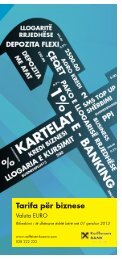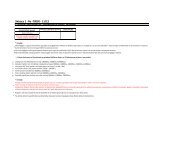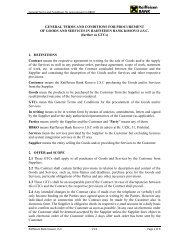Annual Report 2012 - Raiffeisen Bank Kosovo JSC
Annual Report 2012 - Raiffeisen Bank Kosovo JSC
Annual Report 2012 - Raiffeisen Bank Kosovo JSC
You also want an ePaper? Increase the reach of your titles
YUMPU automatically turns print PDFs into web optimized ePapers that Google loves.
4.5 Operational risk<br />
The primary responsibility for the development and implementation of controls to address operational risk is assigned<br />
to senior management within each business unit. This responsibility is supported by the development of overall <strong>Bank</strong><br />
standards for the management of operational risk in the following areas:<br />
<br />
<br />
<br />
<br />
<br />
to address the risks identified<br />
<br />
<br />
<br />
<br />
<br />
Compliance with <strong>Bank</strong> standards is supported by a programme of periodic reviews undertaken by Internal Audit.<br />
The results of Internal Audit reviews are discussed with the management of the business unit to which they relate, with<br />
summaries submitted to the Audit Committee and senior management of the <strong>Bank</strong>.<br />
4.6 Capital Risk Management.<br />
The <strong>Bank</strong> manages its capital to ensure that it will be able to continue as a going concern while maximising the return to<br />
shareholders through the optimisation of the debt and equity balance. The <strong>Bank</strong>’s overall strategy remains unchanged<br />
from previous year. The capital structure of the <strong>Bank</strong> consists of debt, which includes borrowings, and equity attributable<br />
to equity holders, comprising issued capital and retained earnings.<br />
Regulatory capital<br />
<br />
<br />
equal to 15 per cent (fifteen percent) of the relevant indicator. The relevant indicator is the average over three years of<br />
the sum of net interest income and net non-interest income.<br />
Capital Adequacy Ratio<br />
The Capital Adequacy Ratio is the proportion of the regulatory capital to risk weighted assets, off balance-sheet items<br />
and other risks, expressed as a percentage. The minimum required Capital Adequacy Ratio is 8 per cent for Tier 1<br />
capital and 12 per cent for total own funds.<br />
Risk-Weighted Assets (RWAs)<br />
Assets are weighted according to broad categories of national risk, being assigned a risk weighting according to the<br />
amount of capital deemed to be necessary to support them. Six categories of risk weights (0 per cent, 20 per cent,<br />
50 per cent, 75 per cent, 100 per cent, 150 per cent) are applied; for example cash and money market instruments<br />
have a zero risk weighting which means that no capital is required to support the holding of these assets. Property and<br />
equipment carries a 100 per cent risk weighting, meaning that it must be supported by capital (Tier 1) equal to 8 per<br />
cent of the carrying amount.<br />
Off-balance-sheet credit related commitments are taken into account. The amounts are then weighted for risk using the<br />
same percentages as for on-balance-sheet assets.<br />
53<br />
31 December 31 December<br />
<strong>2012</strong> 2011<br />
Total risk weighted assets 419,530 436,091<br />
Total risk weighted off balance exposures 15,446 17,780<br />
Total risk weighted assets for operational risk 55,476 N/A<br />
Total 490,452 453,871<br />
Regulatory capital (Total Capital) 68,591 92,161<br />
Capital adequacy ratio (Total Capital) 13.99% 20.31%<br />
Addresses Glossary Financial Statements Segment <strong>Report</strong>s Overview Macroeconomic Environment RBI Vision and Mission Management Board Introduction

















